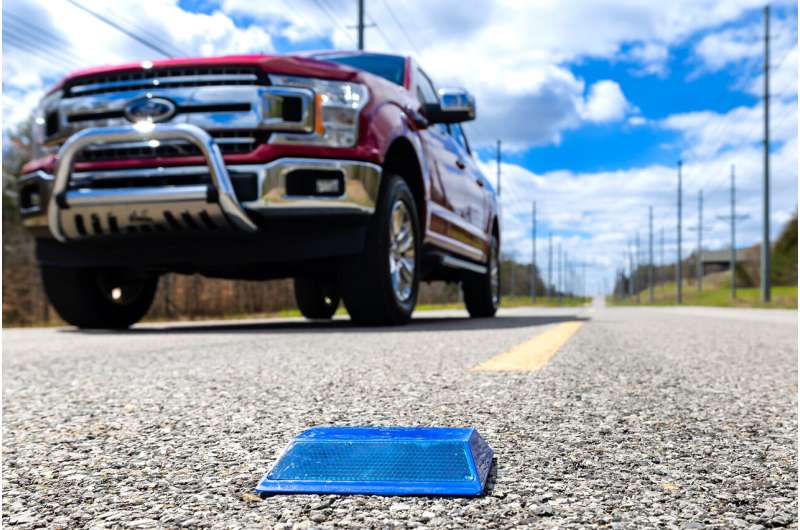This article has been reviewed according to Science X's editorial process and policies. Editors have highlighted the following attributes while ensuring the content's credibility:
fact-checked
trusted source
proofread
High-tech pavement markers support autonomous driving in tough conditions, remote areas

Self-driving electric vehicles still face steep hills on the road to reliability. Researchers from the Department of Energy's Oak Ridge National Laboratory and Western Michigan University are working together to drive solutions from outside the car: sensors and processing embedded in road infrastructure.
Working with partners, ORNL engineers are placing low-powered sensors in the reflective raised pavement markers that are already used to help drivers identify lanes. According to a paper in IEEE Sensors by ORNL researcher Ali Ekti with lead author Sachin Sharma of WMU, microchips inside the markers transmit information to passing cars about the road shape. They are effective even when vehicle cameras or remote laser sensing called LiDAR are unreliable because of fog, snow, glare or other obstructions.
"We are working to make autonomous driving features accurate and safe in more remote areas," Ekti said. "And we are doing it by converting a dummy piece of infrastructure into something with many more uses."
Not only does the technology provide more accurate information about the driving environment, but it also shifts some of the processing load from the car's software onto infrastructure. This saves electric vehicle battery power, extending driving range to promote wider EV adoption. Compared with a leading camera and LiDAR-based autonomous driving technology, the chip-enabled pavement markers can reduce navigational power consumption by up to 90%, the authors reported in a technical paper, available online as part of the SAE Technical Paper Series.
The technology has potential for use with not only tomorrow's self-driving vehicles, but also today's common autonomous driving features, such as lane assist.
The effort is part of a larger project led by WMU, which is teaming with research and industry partners to develop related sensor and autonomous driving technologies such as radar retro-reflectors, high-definition mapping, computational offloading and weather sensing. WMU researchers are also using a vehicle driving on a closed course to measure the reduction in vehicle energy use that is enabled by these technologies, said Zachary Asher, assistant professor of mechanical and aerospace engineering and director of the WMU Energy Efficient and Autonomous Vehicles Lab.
ORNL researchers experimented to find the best combination of transceiver, battery and antenna for the sensor package inside standard road markers, as well as those that are designed to withstand snowplows. They then utilized a communications protocol that involves hopping across a particular radio frequency spectrum up to 50 times a second.
"It's hard to detect, works well against interference, is low cost and doesn't consume a lot of power," Ekti said. Adjustments to the equipment could ensure its battery would last for the same replacement cycle as the pavement markers, typically a year.
Ekti's team created algorithms that triangulate among the GPS coordinates of lane markers to reconstruct an image of the drivable area. One algorithm is embedded in a microchip inside the pavement marker, while a decoding algorithm is incorporated into the car's software.
ORNL researchers field-tested the sensor platform in a variety of weather conditions and in a remote national park in Montana with no wireless access. They found that it transmits more than five times beyond the original 100-meter goal.
"It's amazing how far it can transmit—over hills, in snow. It's a big deal," Asher said. "Every step of the way, we're surprised at how well this technology is working, and we're finding some really cool ways it could be integrated."
The sensors could also signal temporary lane shifts or closures in construction zones when high-definition maps might be out of date. Marker sensors could eventually convey information about temperature, humidity and traffic volume, Ekti said. The project team plans to work with students to build a smaller microchip for the markers as a substitute for more expensive off-the-shelf products.
Asher is planning road demonstrations for stakeholders including the Tennessee and Michigan departments of transportation, the Michigan Office of Future Mobility and the City of Chattanooga. These government agencies decide which technologies are implemented in infrastructure, so their involvement in the development process is critical, Asher said.
Venture capitalists and Silicon Valley have typically regarded self-driving vehicles as a software problem, Asher said. "With the hindsight of 10 years of highly-funded development, we now know that software and cameras alone don't provide an easy solution," he said. "Perhaps a more patient approach, using infrastructure-based hardware in coordination with government transportation agencies, is the way to achieve zero-accident vehicles which actually use energy sustainably."
More information: Sachin Sharma et al, Vehicle Lateral Offset Estimation Using Infrastructure Information for Reduced Compute Load, SAE Technical Paper Series (2023). DOI: 10.4271/2023-01-0800
Sachin Sharma et al, Development and Evaluation of Chip-Enabled Raised Pavement Markers for Lane Line Detection, 2022 IEEE Sensors (2022). DOI: 10.1109/SENSORS52175.2022.9967036




















